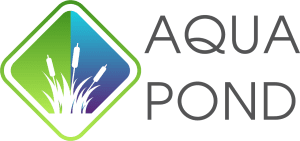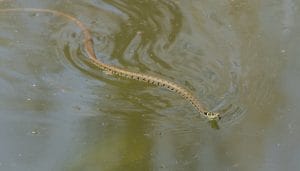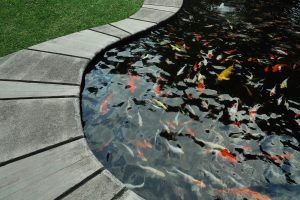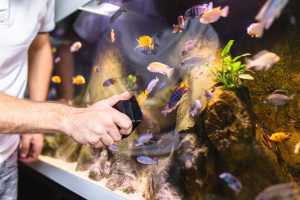
Top Tips for Effective Wildlife Pond Maintenance
Wildlife pond maintenance is essential for keeping your pond healthy and vibrant. This article covers the basics of assessing pond health, seasonal tasks, plant management, algae control, and wildlife care. By following these steps, you can maintain a thriving ecosystem in your pond year-round.
Key Takeaways
Regular assessments of wildlife ponds help maintain a balanced ecosystem by monitoring water quality, managing invasive species, and supporting diverse plant life.
Implementing structured seasonal maintenance tasks is essential, with specific activities such as spring cleaning, summer algae control, autumn preparation, and winter monitoring to ensure pond health year-round.
Utilizing proper tools and equipment, along with adopting long-term management strategies, can significantly enhance the health and sustainability of wildlife ponds.
Assessing Your Wildlife Pond’s Health

Regularly assessing your garden pond’s condition helps maintain a healthy and balanced ecosystem. A good wildlife pond is characterized by clear pond water, diverse plant species, and minimal invasive species. Monitoring the water quality is a primary aspect of this assessment. Excess nutrients can lead to dominance by algae or duckweed, severely affecting water quality and disrupting the ecological balance.
A healthy pond is often indicated by an abundance of underwater vegetation and varied plant species, which contribute to the pond’s health. These plants provide oxygen, shelter, and food for aquatic life, creating a stable environment for pond dwellers. Identifying and managing invasive species is essential since they can outcompete native flora and fauna, causing an imbalanced ecosystem.
Frequent assessments help you spot issues early, enabling corrective measures before they escalate. Look out for signs such as excessive algal blooms, poor water clarity, and the presence of non-native species. By staying vigilant, you can ensure your wildlife pond remains a thriving habitat for local wildlife.
Seasonal Maintenance Tasks

A structured seasonal care routine is vital for maintaining a healthy wildlife pond. Each season presents unique challenges and requirements, necessitating adjustments in maintenance practices.
From spring cleaning to winter watch, understanding the specific needs of your pond throughout the year will help ensure its health and vitality.
Spring Cleaning
Spring is the perfect time to give your wildlife pond a thorough cleaning. While wildlife ponds do not need to be cleaned extensively, removing debris and dead plants is essential to maintain a healthy ecosystem. Start by skimming the pond surface with a net to remove fallen leaves, twigs, and other debris that accumulated over the winter.
Next, focus on the pond edge, where decaying plant material can affect water quality at the pond’s edges. Gently remove any dead or dying plants, but be mindful not to disturb overwintering wildlife.
This cleaning process not only improves the pond’s appearance but also prepares it for the new growth season, ensuring a vibrant and healthy environment for aquatic life.
Summer Care
Summer brings warmer weather, which can lead to increased algae growth in your garden pond. Managing algae is vital to prevent it from disrupting the pond ecosystem and aesthetics. Regularly remove algae by hand and consider introducing submerged plants, which help maintain oxygen levels in the water and support aquatic life.
Providing shade in the pond can also help reduce water temperature and curb excessive algae growth. Floating plants, such as water lilies, are excellent for this purpose. Additionally, ensure adequate water levels are maintained, as evaporation can occur quickly in the summer heat.
These summer care tips help maintain clear and healthy pond water, ensuring a stable environment for all its inhabitants.
Autumn Preparation
Preparing your wildlife pond for the colder months is essential as autumn approaches. Start by removing dying leaves and plant materials to prevent them from decomposing in the pond and affecting water quality. This is especially important as decaying plant matter can lead to nutrient build-up and promote algae growth.
Autumn is also an ideal time to clean the pond, as many aquatic creatures are less active, minimizing disruption to their habitat. This preparation ensures a healthy ecosystem during the winter months, providing a stable environment for overwintering wildlife.
Winter Watch
Winter poses unique challenges for pond maintenance, such as monitoring for ice build-up which can block gas exchange and harm aquatic life. In late autumn and early winter, consider removing some vegetation and placing it around the pond’s edges to provide shelter for overwintering animals.
Keeping a section of the pond free from ice ensures oxygen exchange, crucial for fish and other pond dwellers. By taking these winter watch steps, you can ensure your wildlife pond remains a healthy and supportive environment throughout the colder months.
Managing Pond Plants
Pond plants are vital for maintaining a healthy and balanced garden wildlife pond. A diverse range of plant species helps create favorable conditions for wildlife, providing oxygen, shelter, and food.
From submerged oxygenating plants to floating and emergent plants, each type contributes uniquely to the pond’s ecosystem.
Choosing Native Pond Plants
Selecting native pond plants enhances local biodiversity and avoids issues with non-native species. Avoid invasive alien plants such as Australian swamp stonecrop, Nuttall’s pondweed, and parrot’s feather, as they can outcompete native flora and disrupt the ecosystem.
Necessary types of plants for a wildlife pond include submerged oxygenating plants, emergent plants, marginal plants, and floating plants. Examples of beneficial native plants are curled pondweed, mare’s tail, and water-starwort, which help maintain water quality. The best time to plant these species is during spring and summer.
Using native plants around the pond also helps reduce water temperature during extreme heat, supporting ecosystem resilience. By incorporating a variety of pond plants, you create niches for a wider range of creatures, boosting overall biodiversity.
Planting and Positioning
Proper planting and positioning of pond plants create a balanced environment. Shallow water habitats, especially those less than 30 cm deep, are crucial for amphibian development and overall pond biodiversity. Ensure that approximately 70% of the pond edges are sunny and open to support the growth of emergent plants.
Creating shaded areas in the pond can effectively reduce water temperature and help manage algae growth. Additionally, allowing grass to grow along the pond’s edge enhances habitats for wildlife during changing weather.
Pruning and Controlling Growth
Regular pruning and growth control are vital for maintaining a balanced pond ecosystem. Ideally, plant coverage should be kept around 25% to prevent excessive growth and maintain water quality. Gentle thinning-out every autumn helps manage excess vegetation, especially in nutrient-rich ponds.
Using rakes can aid in managing overgrown plants and clearing sediment from the pond bed. By regularly pruning and controlling plant growth, you ensure that your wildlife pond remains a healthy and vibrant habitat.
Controlling Algae and Maintaining Water Quality

Managing algae growth ensures clear, healthy pond water. Excessive algae can be removed manually by scooping it out with a net and adding it to compost after a few days.
A diverse range of plant species, especially underwater vegetation, supports a healthy pond ecosystem and helps limit algae by competing for nutrients.
Natural Algae Control Methods
Natural methods effectively and environmentally control algae. Positioning plants at the pond margins for shade helps reduce water temperature, which can limit algae growth. Floating plants play a crucial role in managing algae by competing for nutrients.
Common problematic algae include blanketweed and green algae. It is recommended to remove blanketweed by hand to prevent it from spreading. By incorporating these natural algae control methods, you can maintain a clear and healthy pond.
Avoiding Nutrient Build-Up
Preventing nutrient build-up maintains water quality in your wildlife pond. Avoid using tap water for pond replenishment, as it contains high levels of nutrients and chemicals that can lead to nutrient overload. Instead, use rainwater, which is better for aquatic life.
Composting any removed algae before disposal can prevent the release of excess nutrients back into the pond. Proper management of fish waste is also crucial to avoid nutrient build-up that can destabilize the pond ecosystem.
Caring for Pond Wildlife

The well-being of pond wildlife is a key aspect of pond maintenance. Minimizing disturbance during maintenance and providing habitat and shelter are essential for supporting a diverse range of species.
By creating a balanced environment, you can attract wildlife and maintain a thriving ecosystem.
Minimizing Disturbance During Maintenance
Minimizing disturbance during maintenance protects pond dwellers. Fine mesh nets are ideal for capturing small debris like fallen leaves and twigs without disturbing aquatic life. Conducting maintenance activities carefully can prevent harm to pond inhabitants and protect the ecosystem.
Seasonal variations can significantly impact the wildlife supported by ponds, necessitating tailored management strategies. Always remember that even minor disturbances can have significant effects on your pond’s ecosystem.
Providing Habitat and Shelter
Habitat and shelter provision is essential for a good wildlife pond. Creating adjacent habitats, such as letting grass grow along the pond’s edge, supports wildlife movement between areas. A mixture of sunny and shady areas in and around the pond enhances biodiversity by supporting various species.
Using a layer of gravel or flat stones on the shallow side of a small pond allows animals to drink safely and creates a habitat for insects. Creating varied environments within small ponds is essential to catering to the different needs of wildlife.
Equipment and Tools for Pond Maintenance
The right tools are crucial for effective wildlife pond maintenance. Essential tools for pond upkeep include nets for debris removal and rakes for managing aquatic plants.
Utilizing these tools contributes significantly to sustaining the health and appearance of your pond.
Nets and Rakes
Nets and rakes efficiently remove debris and manage aquatic plant growth. Using fine mesh nets helps efficiently remove leaves and debris from the pond surface without disturbing aquatic life.
By regularly using nets and rakes, you can maintain a balanced aquatic ecosystem and support overall pond health.
Aeration Devices
Aeration devices are vital for maintaining water oxygenation, especially in deeper ponds. Devices like fountains and pumps enhance oxygen levels, promoting a healthier aquatic environment. Using a solar-powered aerator can also enhance water circulation while reducing energy costs.
Aerators can prevent stagnant water by improving oxygen levels, benefiting aquatic life. During winter, using a pump to circulate water helps prevent freezing and maintains oxygen levels for fish and other pond dwellers. By incorporating aeration devices, you can ensure a balanced ecosystem in your garden pond.
Water Testing Kits
Regular testing of water quality is crucial for monitoring pH levels, nutrient content, and overall pond health. Water testing kits allow you to keep track of essential parameters such as ammonia, nitrite, and pH, helping you make informed decisions about pond maintenance.
Many pond maintenance tasks, including water testing and algae control, can be managed by homeowners with the right resources and basic knowledge. By regularly testing your pond water, you can ensure a healthy environment for all its inhabitants.
Long-Term Pond Management Strategies

Long-term management strategies sustain the health and vitality of your wildlife pond. Consistent observation and proactive maintenance are key to ensuring your pond remains a thriving ecosystem throughout the year.
Seasonal maintenance tasks play a significant role in this, as different tasks are required in each season to maintain optimal pond health.
Adapting to Climate Changes
Adapting your wildlife pond to climate changes ensures its long-term health. Mechanisms for overflow during heavy rainfall mitigate flooding risks and preserve habitat stability. Additionally, maintaining water levels during droughts helps ensure the pond does not dry out, which could harm aquatic life.
These strategies create a resilient environment that naturally fluctuates with changing weather patterns. This adaptability ensures your pond remains a sustainable habitat for local wildlife.
Future-Proofing Your Pond
Future-proofing your pond involves taking measures to sustain its biodiversity in changing climate conditions. Monitoring water levels, especially during droughts, prevents the pond from drying out and ensures habitat sustainability.
Creating physical structures, such as log piles and ramps, can improve access and habitats for wildlife while preventing erosion. Managing water levels effectively and preventing erosion help create a thriving environment that supports a diverse range of species.
Proactively addressing potential challenges ensures your pond remains a vibrant and healthy ecosystem for years to come.
DIY vs. Professional Pond Maintenance
Choosing between DIY and professional pond maintenance depends on the pond’s size, complexity, and the owner’s experience. DIY pond maintenance can result in significant cost savings and a deeper understanding of the ecosystem.
However, there are situations where professional assistance might be necessary, such as dealing with large ponds or complex ecological issues.
Benefits of DIY Maintenance
DIY maintenance offers substantial cost savings and flexibility to work according to your schedule. Hands-on pond care typically enhances personal satisfaction and connection to nature. The combination of cost savings and personal satisfaction makes DIY maintenance a rewarding choice for pond owners.
Maintaining your pond yourself attunes you to the ecosystem, leading to greater appreciation and understanding of the natural world.
When to Call a Professional
Sometimes, calling a professional for pond maintenance is advisable. If your pond has persistent issues that cannot be resolved through basic maintenance, seeking expert help ensures these problems are addressed effectively. Professionals can manage seasonal changes with at least four maintenance visits annually, ensuring your pond’s ecosystem remains balanced.
Sometimes, calling a professional for pond maintenance is advisable. If your pond has persistent issues that cannot be resolved through basic maintenance, seeking expert help ensures these problems are addressed effectively. Professionals can manage seasonal changes with at least four maintenance visits annually, ensuring your pond’s ecosystem remains balanced.
Summary
Maintaining a wildlife pond involves a combination of regular assessments, seasonal maintenance tasks, careful management of pond plants, and ensuring water quality. By following these guidelines, you can create a thriving habitat that supports a diverse range of wildlife. Whether you choose DIY maintenance or seek professional help, the key is to stay proactive and attentive to your pond’s needs. Keep your garden wildlife pond in tip-top shape, and enjoy the beauty and biodiversity it brings to your garden.
Frequently Asked Questions
How often should I assess my pond’s health?
To maintain optimal water quality and ecosystem health, it is advisable to assess your pond’s condition at least once a month. Regular evaluations will help you identify and address any potential issues promptly.
What plants should I avoid in my wildlife pond?
You should avoid invasive alien plants such as Australian swamp stonecrop, Nuttall’s pondweed, and parrot’s feather in your wildlife pond to maintain a healthy ecosystem. These species can disrupt local habitats and outcompete native flora.
How can I control algae naturally in my pond?
Controlling algae naturally in your pond can be effectively achieved by introducing floating plants to compete for nutrients, manually removing blanketweed, and providing shade to lower water temperature. Implementing these methods will help maintain a balanced ecosystem.
When is the best time to plant pond plants?
The optimal time to plant pond plants is in the spring and summer months, ensuring they establish well during the growing season. This timing supports healthy growth and thriving aquatic life.
What are the benefits of using rainwater instead of tap water for my pond?
Using rainwater for your pond is beneficial as it helps manage nutrient levels and supports healthier aquatic life, avoiding the risks of nutrient overload commonly associated with tap water.



